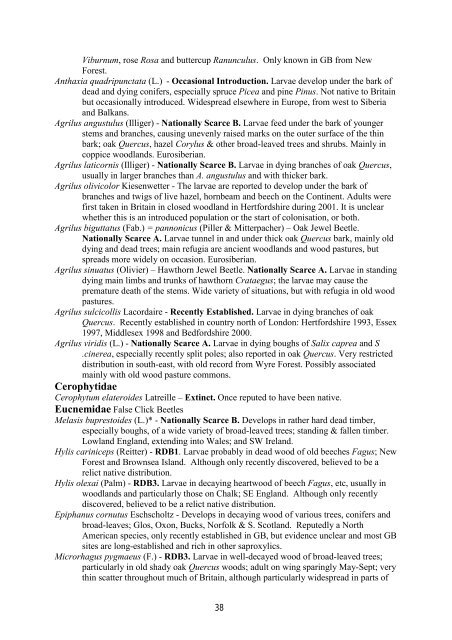Crustacea: Copepoda - Cerambycoidea.com
Crustacea: Copepoda - Cerambycoidea.com
Crustacea: Copepoda - Cerambycoidea.com
You also want an ePaper? Increase the reach of your titles
YUMPU automatically turns print PDFs into web optimized ePapers that Google loves.
Viburnum, rose Rosa and buttercup Ranunculus. Only known in GB from New<br />
Forest.<br />
Anthaxia quadripunctata (L.) - Occasional Introduction. Larvae develop under the bark of<br />
dead and dying conifers, especially spruce Picea and pine Pinus. Not native to Britain<br />
but occasionally introduced. Widespread elsewhere in Europe, from west to Siberia<br />
and Balkans.<br />
Agrilus angustulus (Illiger) - Nationally Scarce B. Larvae feed under the bark of younger<br />
stems and branches, causing unevenly raised marks on the outer surface of the thin<br />
bark; oak Quercus, hazel Corylus & other broad-leaved trees and shrubs. Mainly in<br />
coppice woodlands. Eurosiberian.<br />
Agrilus laticornis (Illiger) - Nationally Scarce B. Larvae in dying branches of oak Quercus,<br />
usually in larger branches than A. angustulus and with thicker bark.<br />
Agrilus olivicolor Kiesenwetter - The larvae are reported to develop under the bark of<br />
branches and twigs of live hazel, hornbeam and beech on the Continent. Adults were<br />
first taken in Britain in closed woodland in Hertfordshire during 2001. It is unclear<br />
whether this is an introduced population or the start of colonisation, or both.<br />
Agrilus biguttatus (Fab.) = pannonicus (Piller & Mitterpacher) – Oak Jewel Beetle.<br />
Nationally Scarce A. Larvae tunnel in and under thick oak Quercus bark, mainly old<br />
dying and dead trees; main refugia are ancient woodlands and wood pastures, but<br />
spreads more widely on occasion. Eurosiberian.<br />
Agrilus sinuatus (Olivier) – Hawthorn Jewel Beetle. Nationally Scarce A. Larvae in standing<br />
dying main limbs and trunks of hawthorn Crataegus; the larvae may cause the<br />
premature death of the stems. Wide variety of situations, but with refugia in old wood<br />
pastures.<br />
Agrilus sulcicollis Lacordaire - Recently Established. Larvae in dying branches of oak<br />
Quercus. Recently established in country north of London: Hertfordshire 1993, Essex<br />
1997, Middlesex 1998 and Bedfordshire 2000.<br />
Agrilus viridis (L.) - Nationally Scarce A. Larvae in dying boughs of Salix caprea and S<br />
.cinerea, especially recently split poles; also reported in oak Quercus. Very restricted<br />
distribution in south-east, with old record from Wyre Forest. Possibly associated<br />
mainly with old wood pasture <strong>com</strong>mons.<br />
Cerophytidae<br />
Cerophytum elateroides Latreille – Extinct. Once reputed to have been native.<br />
Eucnemidae False Click Beetles<br />
Melasis buprestoides (L.)* - Nationally Scarce B. Develops in rather hard dead timber,<br />
especially boughs, of a wide variety of broad-leaved trees; standing & fallen timber.<br />
Lowland England, extending into Wales; and SW Ireland.<br />
Hylis cariniceps (Reitter) - RDB1. Larvae probably in dead wood of old beeches Fagus; New<br />
Forest and Brownsea Island. Although only recently discovered, believed to be a<br />
relict native distribution.<br />
Hylis olexai (Palm) - RDB3. Larvae in decaying heartwood of beech Fagus, etc, usually in<br />
woodlands and particularly those on Chalk; SE England. Although only recently<br />
discovered, believed to be a relict native distribution.<br />
Epiphanus cornutus Eschscholtz - Develops in decaying wood of various trees, conifers and<br />
broad-leaves; Glos, Oxon, Bucks, Norfolk & S. Scotland. Reputedly a North<br />
American species, only recently established in GB, but evidence unclear and most GB<br />
sites are long-established and rich in other saproxylics.<br />
Microrhagus pygmaeus (F.) - RDB3. Larvae in well-decayed wood of broad-leaved trees;<br />
particularly in old shady oak Quercus woods; adult on wing sparingly May-Sept; very<br />
thin scatter throughout much of Britain, although particularly widespread in parts of<br />
38

















